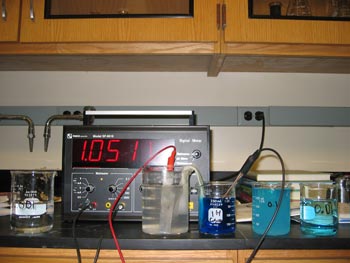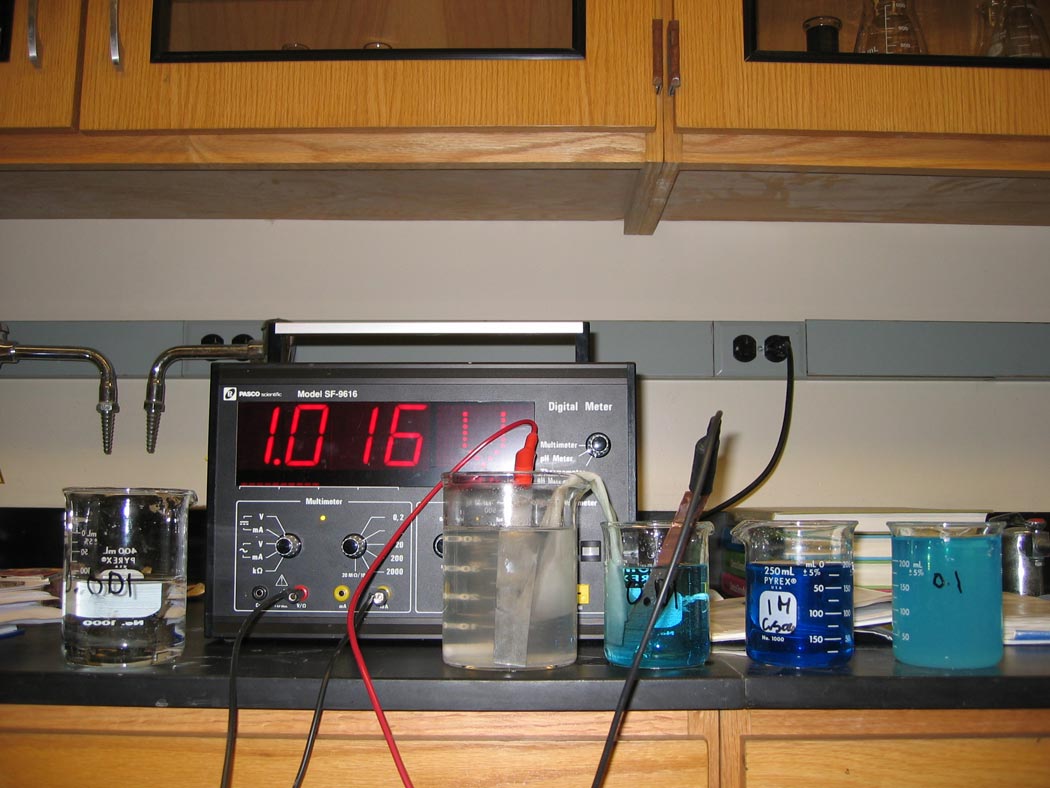Exploring the spontaneous chemistry that is the power behind the battery
 Electrodes of copper and zinc are immersed in salt solutions and brought into contact through a wire, leading to a spontaneous reduction/oxidation reaction.
Electrodes of copper and zinc are immersed in salt solutions and brought into contact through a wire, leading to a spontaneous reduction/oxidation reaction.
Ingredients: copper sulfate, zinc sulfate, voltmeter, filter paper, ammonium nitrate
Procedure: A complete recipe follows.
1. Prepare 1.0M, 0.1M and 0.01M aqueous solutions of copper sulfate.
2. Prepare 1.0M, 0.1M and 0.01M aqueous solutions of zinc sulfate.
3. Soak filter paper in ammonium nitrate solution to act as ``salt bridge."
4. Immerse copper electrode in copper sulfate solution and zinc electrode in zinc sulfate solution.
5. Add salt bridge between two solutions.
6. Connect voltmeter across the half-cells and measure voltage.
7. Repeat measurements for various combinations of solution concentrations.
Understanding: We have observed that the electrochemical reaction
Zn(s) + Cu2+(aq) → Zn2+(aq) + Cu(s)
occurs in a spontaneous manner towards an equilibrium that favors the formation of products solid copper metal and zinc ions in solution. The measure of the driving force of this reaction is the change in Gibbs free energyΔ GoZn|Zn2+||Cu2+|Cu = -n F EoZn|Zn2+||Cu2+|Cu
Using the standard reduction potentials for the copper and zinc half cells, we findEoZn|Zn2+||Cu2+|Cu = EoCu2+|Cu - EoZn2+|Zn = 0.34V - (-0.76V) = 1.10V
The fact that EoZn2+|Zn < EoCu2+|Cu indicates that the reaction will proceed from the standard state conditions of 1.0M solutions of copper and zinc ions to an equilibrium state of increased zinc ion and decreased copper ion concentrations.These are relations at standard state, but we have similar relations for the cell potential at any concentrations or pressures of reactants or products
Δ GZn|Zn2+||Cu2+|Cu = -n F EZn|Zn2+||Cu2+|Cu
The relationship between cell voltage, and the concentrations and pressures of reactants and productsWe would like to know how the cell voltage E depends upon the cell voltage at standard state and the concentrations and pressures of reactants and products. It turns out that it is easy to answer that question by making use of the principal result of our study of chemical thermodynamics
ΔG = Δ Go + RT ln Q
That result defines the driving force for any chemical reaction, ΔG, as a function of the standard state free energy change, ΔGo, and the reaction quotient, Q.As the reaction approaches the state of equilibrium, the reaction quotient becomes the equilibrium constant, K, and ΔG=0. That leads to the relation between the equilibrium constant, K, and the standard state free energy change, ΔGo, which is
ΔG = 0 = ΔGo + RT ln K
which can also be written K = exp(-ΔGo/RT).To determine the dependence of the cell voltage on concentrations, pressure and temperature, all we need to do is substitute our relation between the Gibbs free energy change and the cell voltage
ΔG = -n F E
to find-n F E = -n F Eo + RT ln Q
Dividing each term by -nF we find the fundamental relation of electrochemistry, the Nernst equationE = Eo - (RT/nF) ln Q (at any temperature)
which defines the cell voltage as a function of the concentrations, pressures, and temperature. The result is valid at any temperature.It turns out that we have 10 fingers, and so we like to think in terms of powers of 10, and not powers of e. If we had e fingers, things would be different! So it is convenient to replace the natural logarithm with the base 10 logarithm
ln Q = ln 10log10Q = ln 10 x log10 Q = 2.3026 log10 Q
Most electrochemical experiments are run at 25C. If we restrict the temperature to 25C, and note thatln(10) RT/nF = 2.3026 x 8.314 CV/(mol K) x 298.15K / (n 96,485 C/mol) = 0.0592V /n
we find the special case of the Nernst equationE = Eo - (0.0592V/n) log10 Q (at 25C)
The cell voltage at standard state and the equilibrium constantAt the point of equilibrium, there is no driving force in the reaction, the voltage is zero, an there is no net flow of electrons. At that point
E = 0 = Eo - (0.0592V/n) log10 Q
so thatK = 10nEo/0.0592V (at 25C)
which relates the cell voltage measured at standard state to the equilibrium constant! We see that if we create an electrochemical cell at standard state conditions and 25C, we can measure the cell voltage and make a very accurate estimate of the equilibrium constant for the reaction.
Analyzing the concentration dependence of the Zn/Zn2+||Cu2+|Cu galvanic cell
For the galvanic cell at 25C we find
EZn/Zn2+||Cu2+|Cu =
EoZn/Zn2+||Cu2+|Cu
- (0.0592V/n) log10 Q
(at 25C)
EZn/Zn2+||Cu2+|Cu =
1.10 V - 0.0296V log10 [Zn2+]/[Cu2+]
(at 25C)
EZn/Zn2+||Cu2+|Cu = 1.10V
If we increase the concentration of zinc relative to that of copper so that [Zn2+]=1.0M and [Cu2+]=0.1M, Q=10, log10Q=1 and
EZn/Zn2+||Cu2+|Cu = 1.07V
If we decrease the concentration of zinc relative to that of copper so that [Zn2+]=0.01M and [Cu2+]=0.1M, Q=0.1, log10Q=-1 and
EZn/Zn2+||Cu2+|Cu = 1.13V
Finally, using the standard state cell voltage we can determine the equilibrium constant for this reaction
K = [Zn2+]/[Cu2+] = 10nEo/0.0592V = 1037.2 = 1 x 1037
(at 25C)
[Co2+] [Ni2+]
You can check your answers here.
 This is a very interesting result! We can see that for every change in the reaction quotient by a power of 10, we will change the cell voltage by 0.0296V, up or down. For example, at standard state conditions [Zn2+]=[Cu2+]=1.0M so that Q=1, log10 1 = 0, and
This is a very interesting result! We can see that for every change in the reaction quotient by a power of 10, we will change the cell voltage by 0.0296V, up or down. For example, at standard state conditions [Zn2+]=[Cu2+]=1.0M so that Q=1, log10 1 = 0, and
Predicting the change in cell voltage as a function of solution concentrations
Question:
Determine the cell voltage for the galvanic cell
Co/Co2+||Ni2+|Ni for the following concentration ratios at 25C.
1.0M 1.0M
0.1M 1.0M
0.01M 1.0M
0.1M 0.1M
0.1M 0.001M